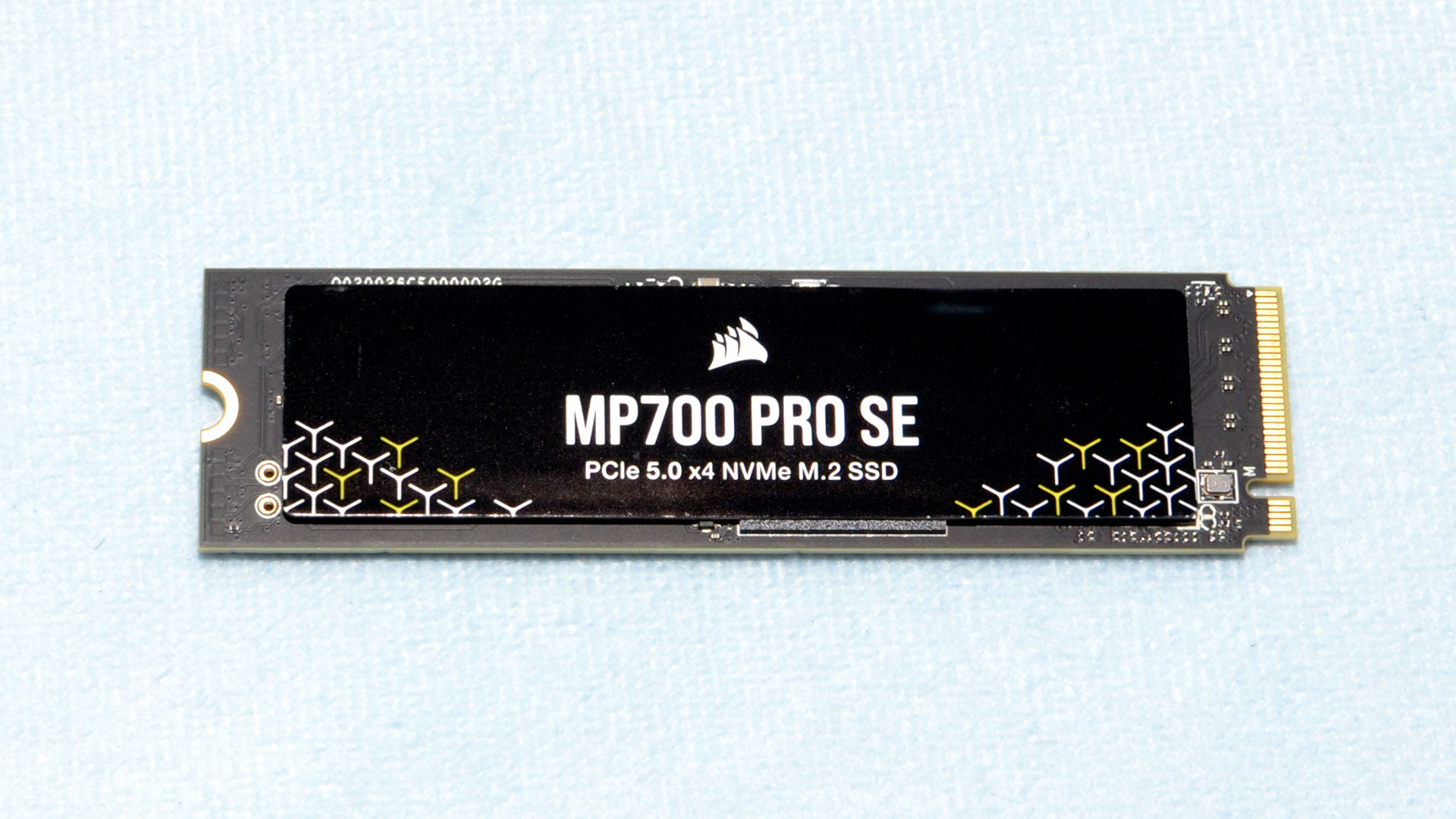Why you can trust Tom's Hardware
Comparison Products
We’re testing the Corsair MP700 Pro SE against a variety of drives today to help direct your purchasing decision. Is it worth getting this drive over the earlier, slower PCIe 5.0 SSDs? We'll include the Corsair MP700 Pro 2TB, which peaks at around 10 GB/s, as well as the Crucial T700 4TB which can reach around 12 GB/s, to find out.
What about upgrading from an older PCIe 3.0 SSD? The WD Red SN700 — which has similarities to the WD Black SN750 — is a good measure for that. If you were an early adopter of the PCIe 4.0 SSDs, the Sabrent Rocket Q4 comparison will show you just how far the technology has come (and how QLC can hinder performance on higher capacity drives).
Phison’s venerable E18 remains a solid choice if you want DRAM on a budget. We’ll include the Netac NV7000, Sabrent Rocket 4 Plus-G, Seagate FireCuda 530, and Teamgroup Cardea A440 Pro/Special Series in our charts as well. The best overall 4GB PCIe 4.0 drive is probably the Samsung 990 Pro, though, and maybe that’s enough performance for your high-end build, so pay attention to that one in our benchmarks.
DRAM-less SSDs have also become very attractive — particularly if power efficiency and pricing matters to you. These are best represented by the Lexar NM790 and Addlink A93. The Teamgroup MP44 should also be good, even if we don’t have it in the charts for this review as we haven't tested the 4TB variant of that drive.
Trace Testing — 3DMark Storage Benchmark
Built for gamers, 3DMark’s Storage Benchmark focuses on real-world gaming performance. Each round in this benchmark stresses storage based on gaming activities including loading games, saving progress, installing game files, and recording gameplay video streams. Future gaming benchmarks will be DirectStorage-inclusive and we include details of that where possible.
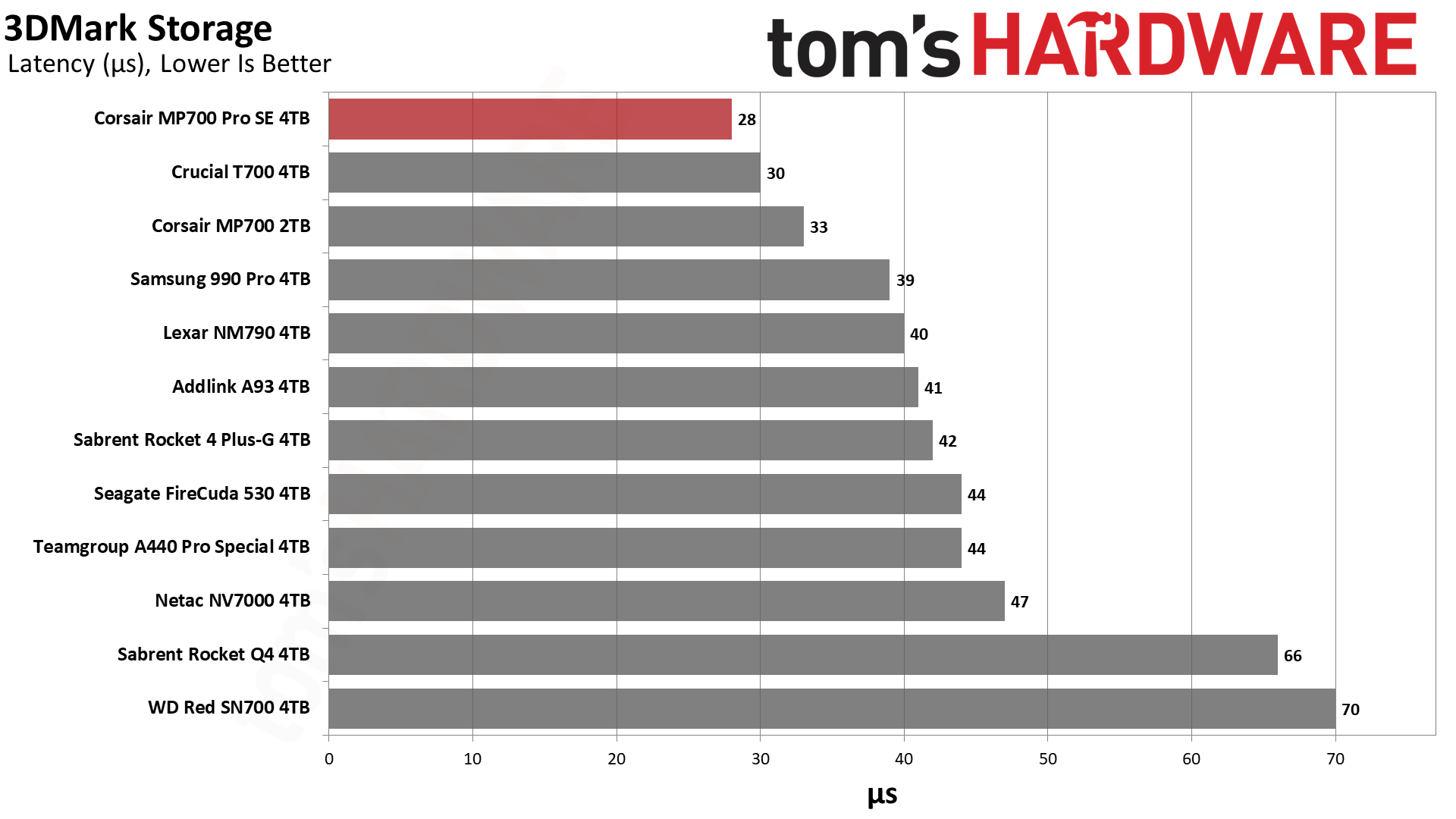
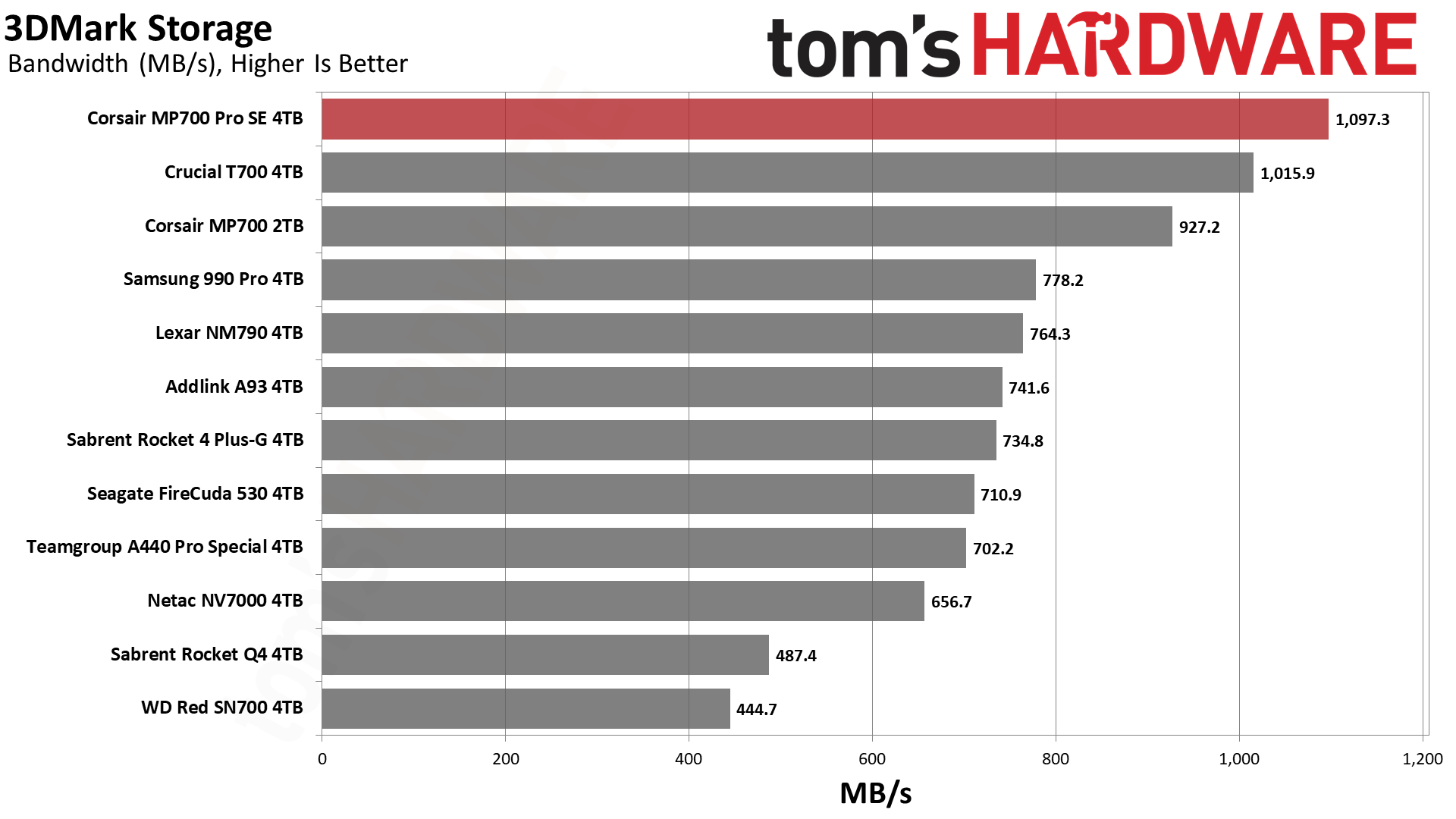
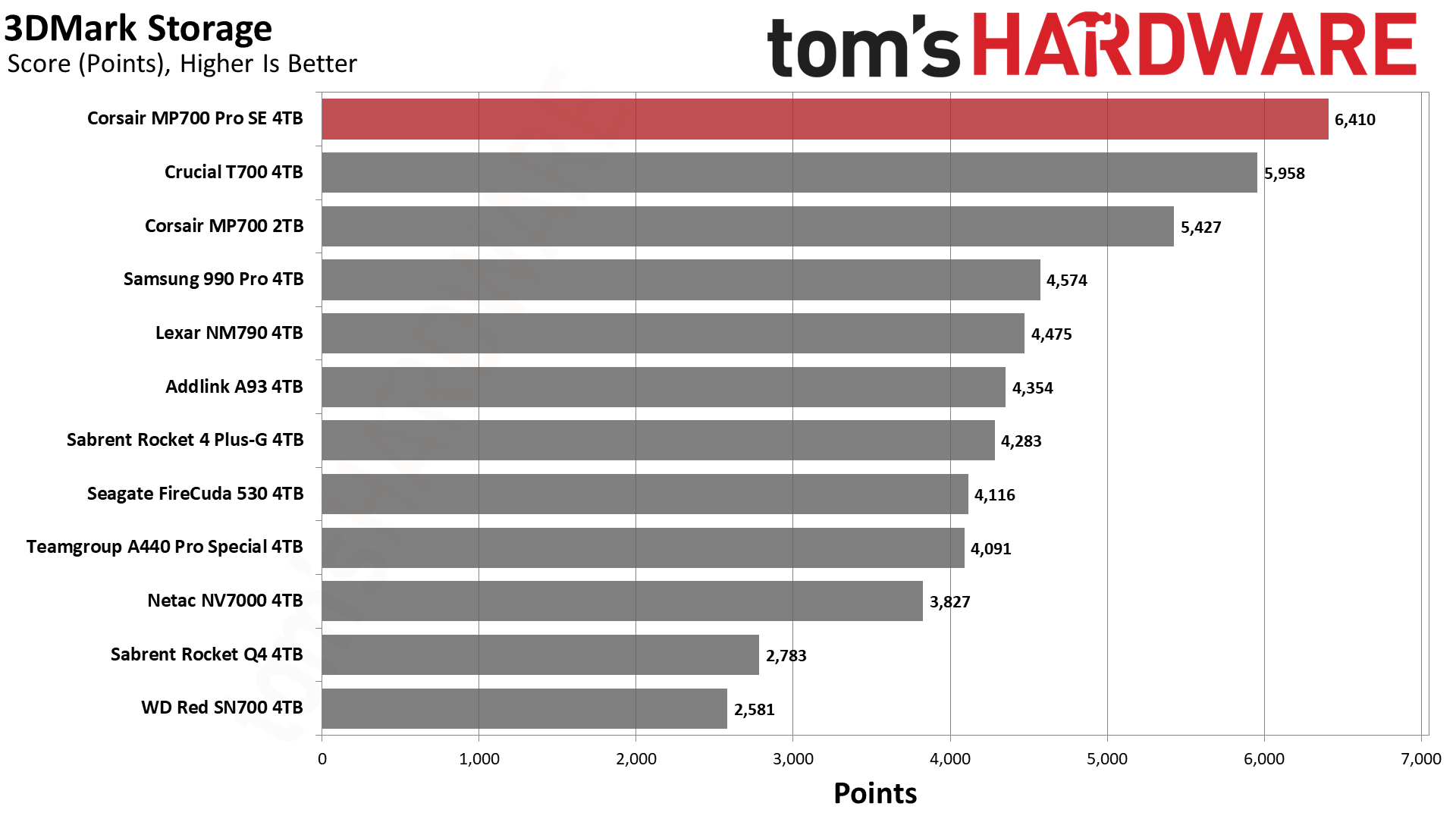
The MP700 Pro SE has excellent 3DMark performance, easily besting the rest of the field. The extra bandwidth and improved latency — thanks to the 2400 MT/s bus and flash — gives a better result than the 2000 MT/s T700 4TB and 1600 MT/s MP700. Earlier generation drives, including PCIe 4.0, are no match for the newest Phison E26 SSDs.
The MP700 Pro SE does have Phison’s I/O+ firmware that's optimized for DirectStorage. While all of the PCIe 5.0 SSDs with this controller include this firmware, it’s otherwise limited to just a few PCIe 4.0 drives. This includes the Rocket 4 Plus-G, the FireCuda 530 with an update, and one or two other drives based on the Phison E18 controller. Crucial’s T500 also has DirectStorage optimized firmware, and it’s due to arrive for E27T-based drives like the new Sabrent Rocket 4, as well. Regardless, for future-proofing the MP700 Pro SE should be a good choice.
Trace Testing — PCMark 10 Storage Benchmark
PCMark 10 is a trace-based benchmark that uses a wide-ranging set of real-world traces from popular applications and everyday tasks to measure the performance of storage devices.
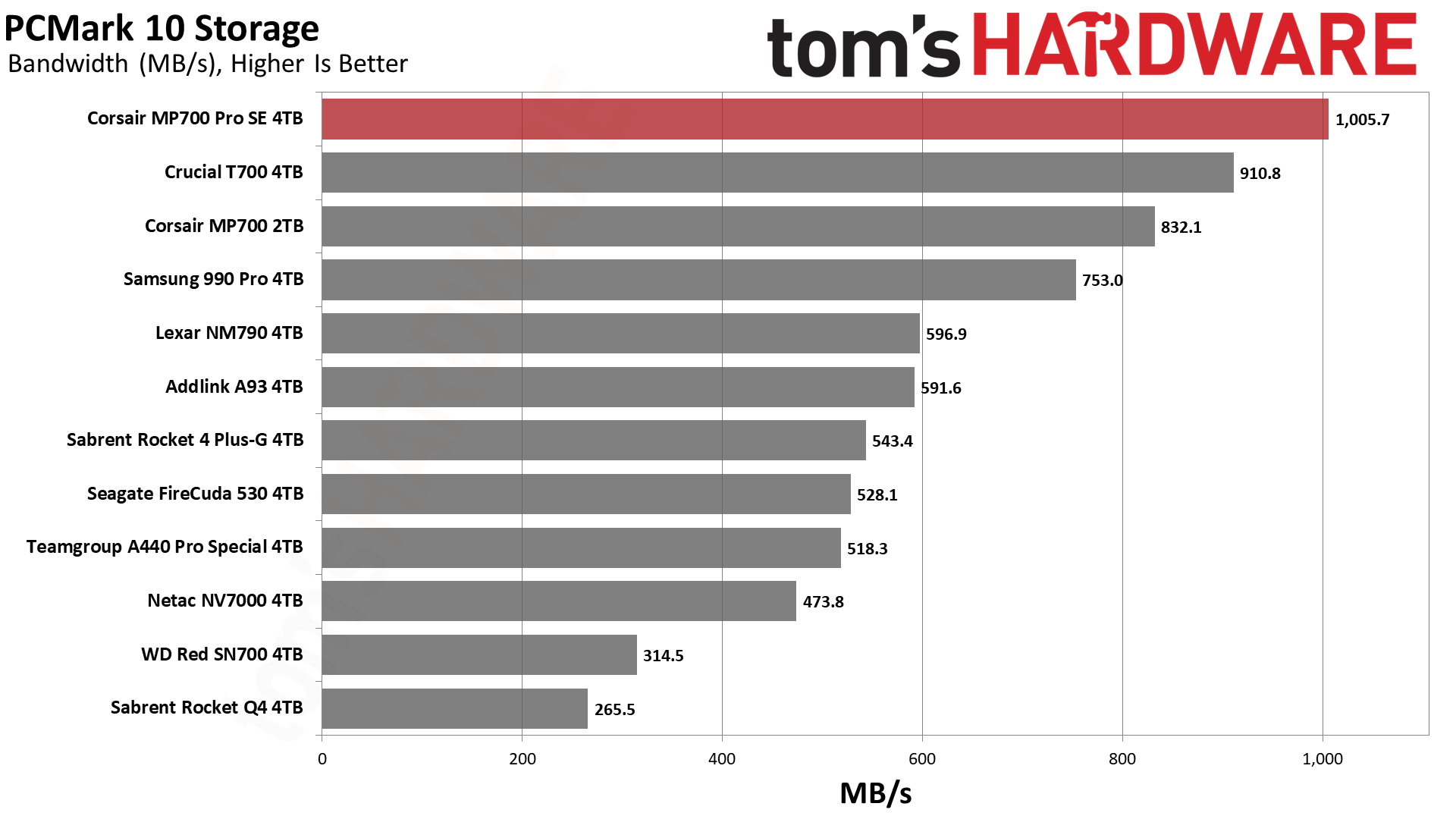
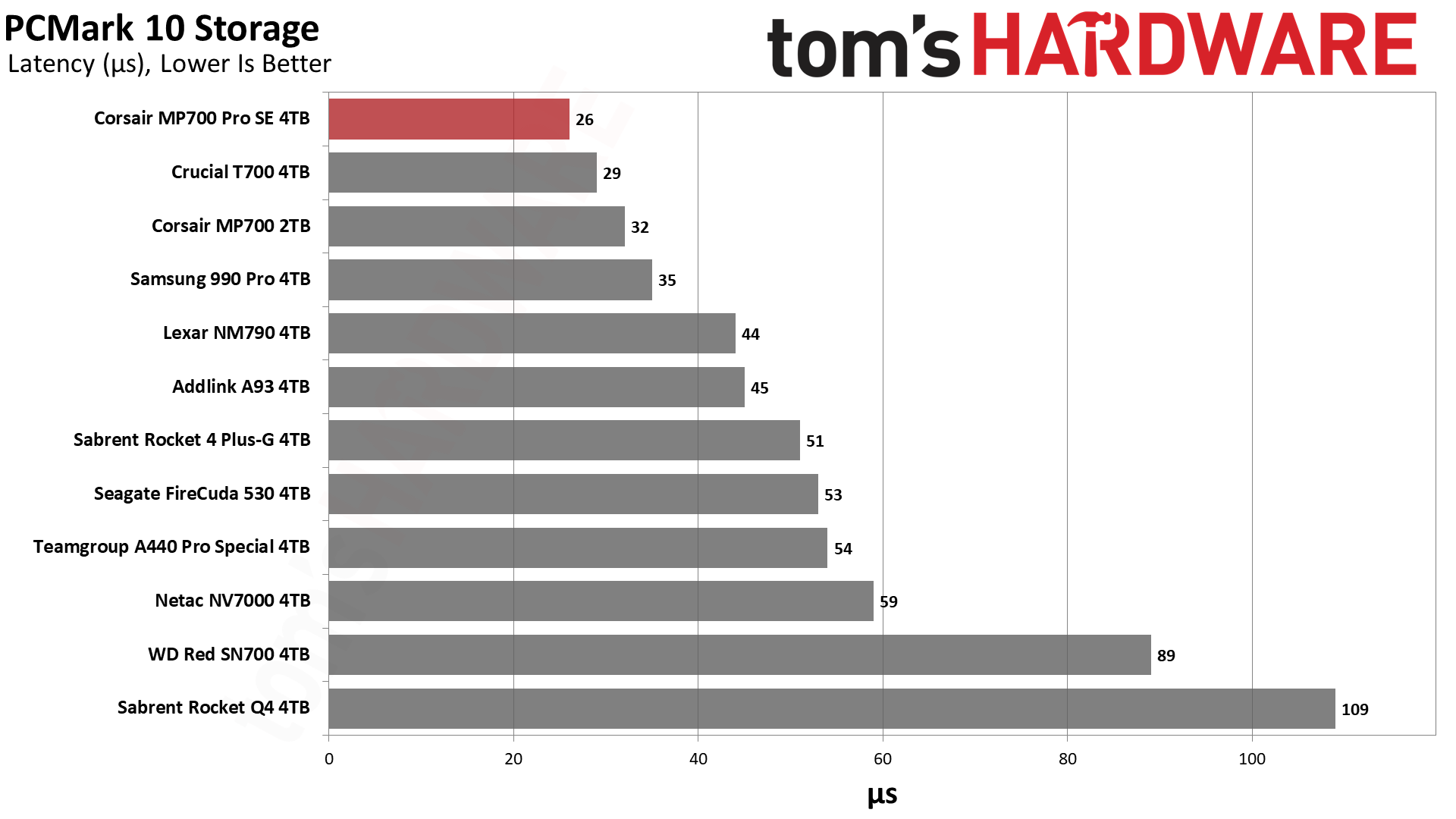
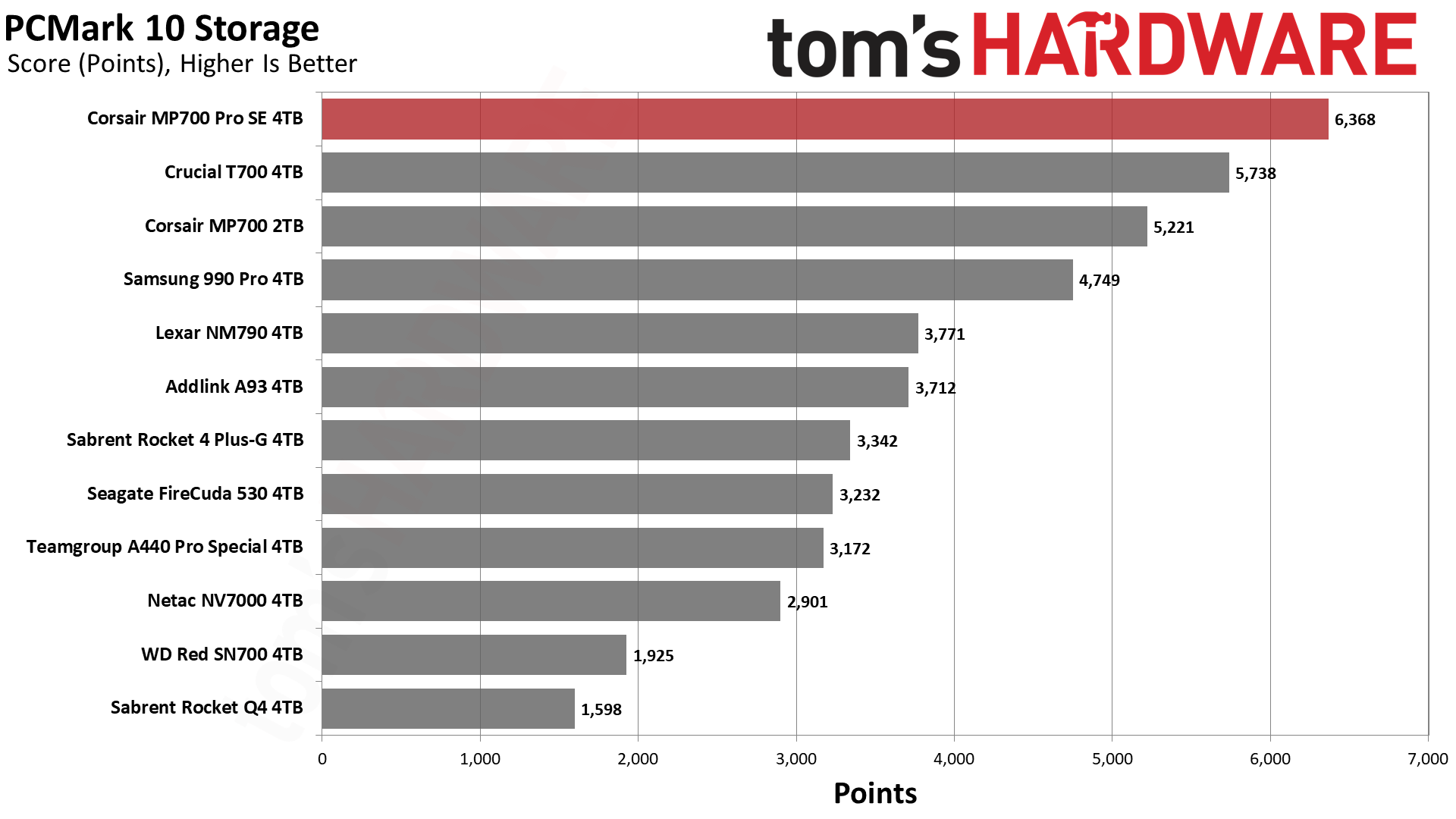
Unsurprisingly, the MP700 Pro SE also dominates in PCMark 10's storage test. The exceptional latency makes for a monster drive for applications, even before looking at bandwidth. It’s probably worth going for this one over the earlier MP700 if you’re going with a PCIe 5.0 drive.
Note that DirectStorage isn't just for games, as it can improve performance significantly in applications that can use it. That makes this optimized drive a good choice for HEDT or workstation use as well.
Transfer Rates — DiskBench
We use the DiskBench storage benchmarking tool to test file transfer performance with a custom, 50GB dataset. We write 31,227 files of various types, such as pictures, PDFs, and videos to the test drive, then make a copy of that data to a new folder, and follow up with a reading test of a newly-written 6.5GB zip file. This is a real world type workload that fits into the cache of most drives. (Note that the 50GB write test typically gets bottlenecked by the source Sabrent Rocket 4 Plus 2TB drive, as that peaks at PCIe 4.0 speeds.)
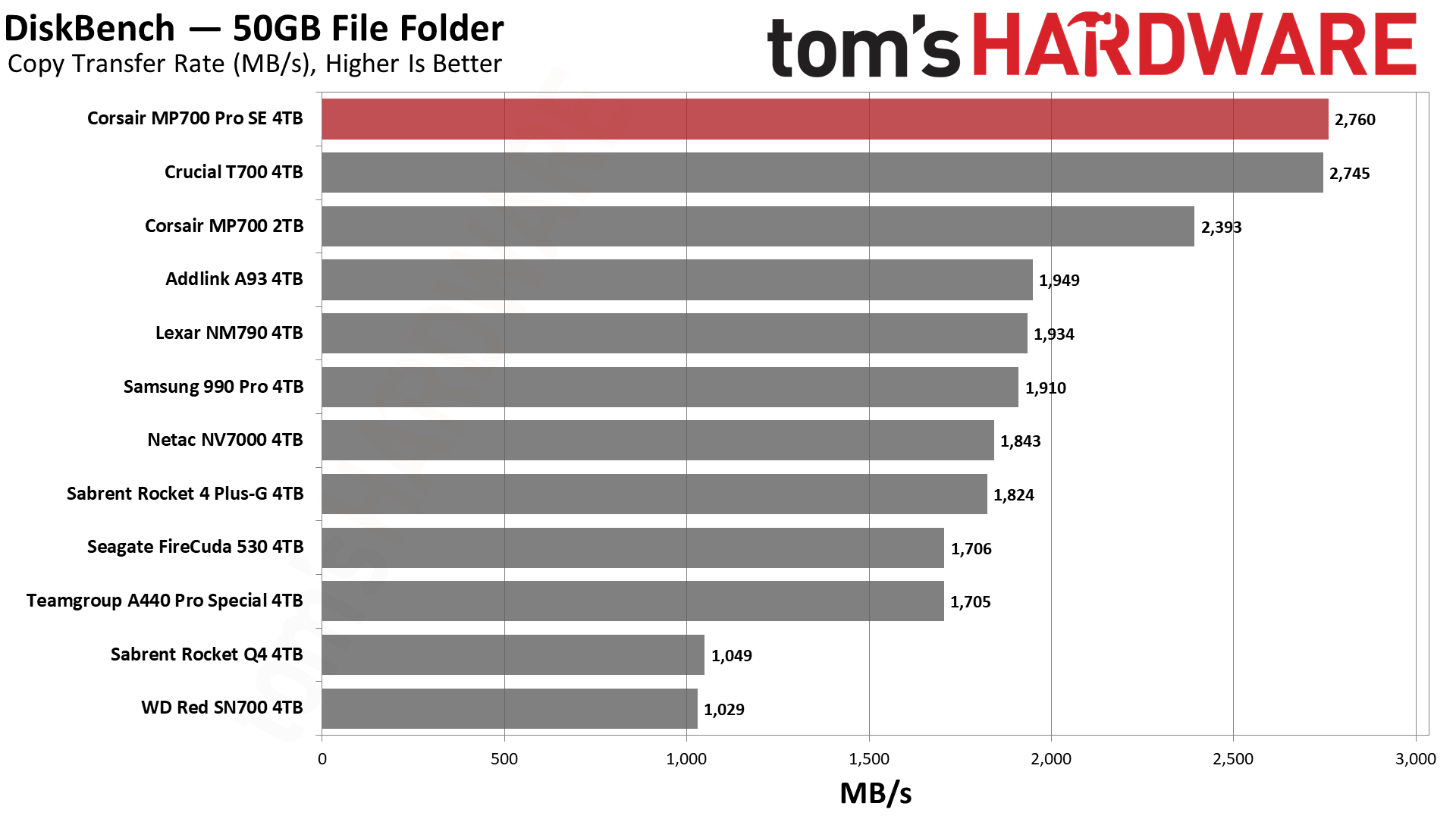

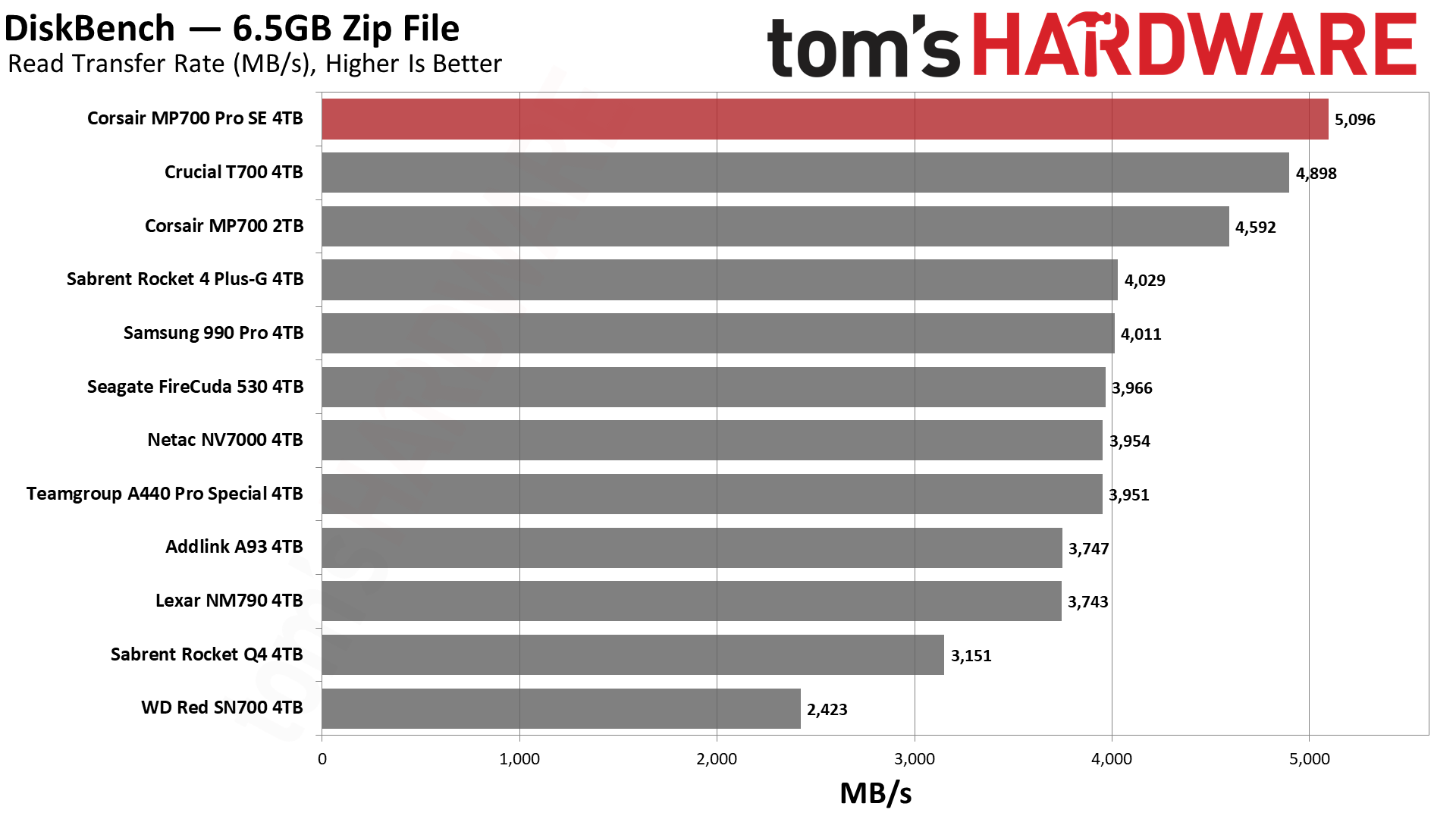
The biggest selling point of a PCIe 5.0 SSD is its maximum throughput. However, many file transfers occur at a low queue depth and with files of varying size. If you are unable to fully thread for the drive, or need to transfer smaller files, real world transfer performance will be lower than you might expect. However, having a faster bus with fast flash on a faster interface still translates to real gains. None of the PCIe 4.0 drives can hope to match the MP700 Pro SE.
Get Tom's Hardware's best news and in-depth reviews, straight to your inbox.
Synthetic Testing — ATTO / CrystalDiskMark
ATTO and CrystalDiskMark (CDM) are free and easy-to-use storage benchmarking tools that SSD vendors commonly use to assign performance specifications to their products. Both of these tools give us insight into how each device handles different file sizes and at different queue depths.
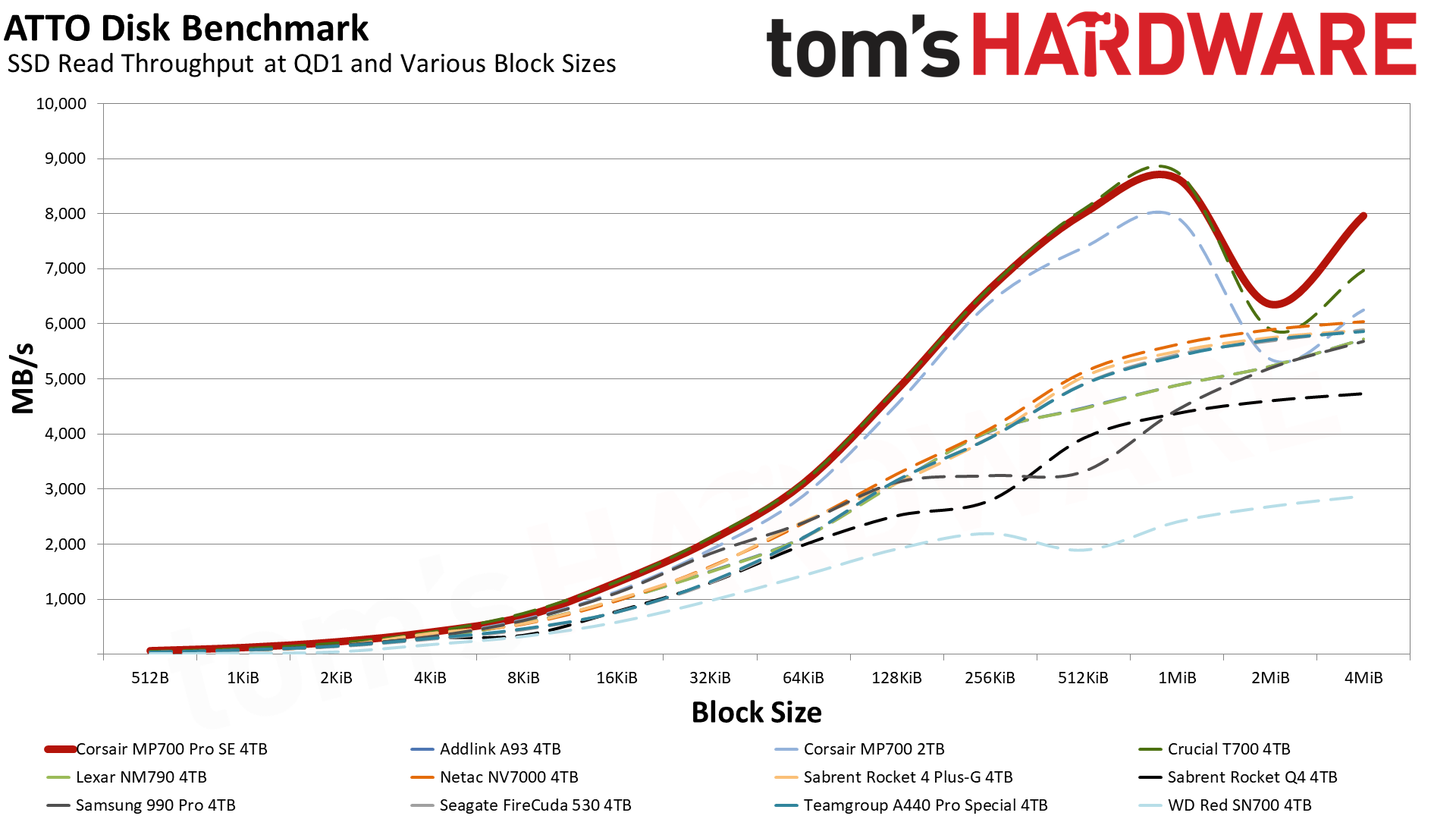
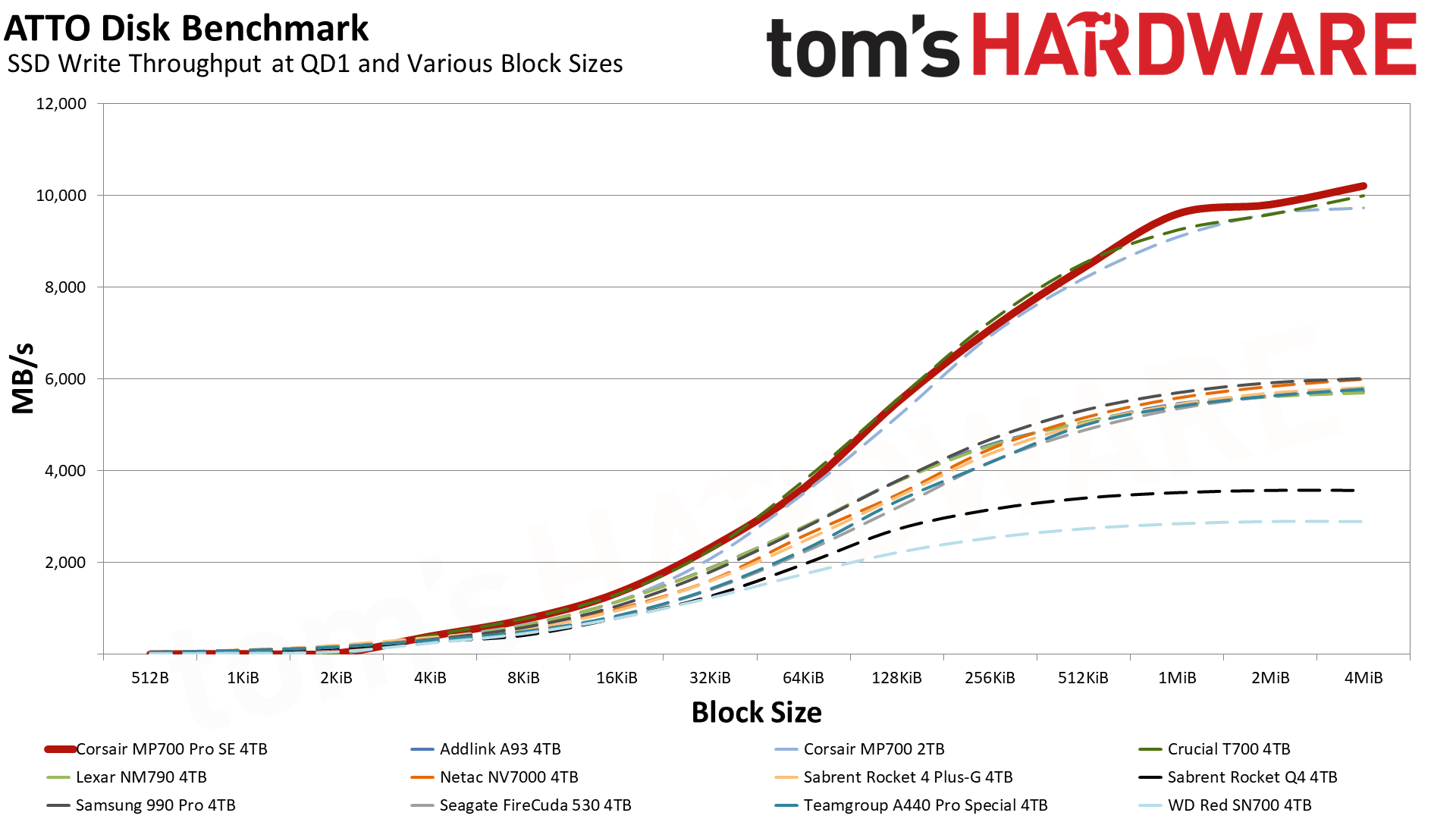
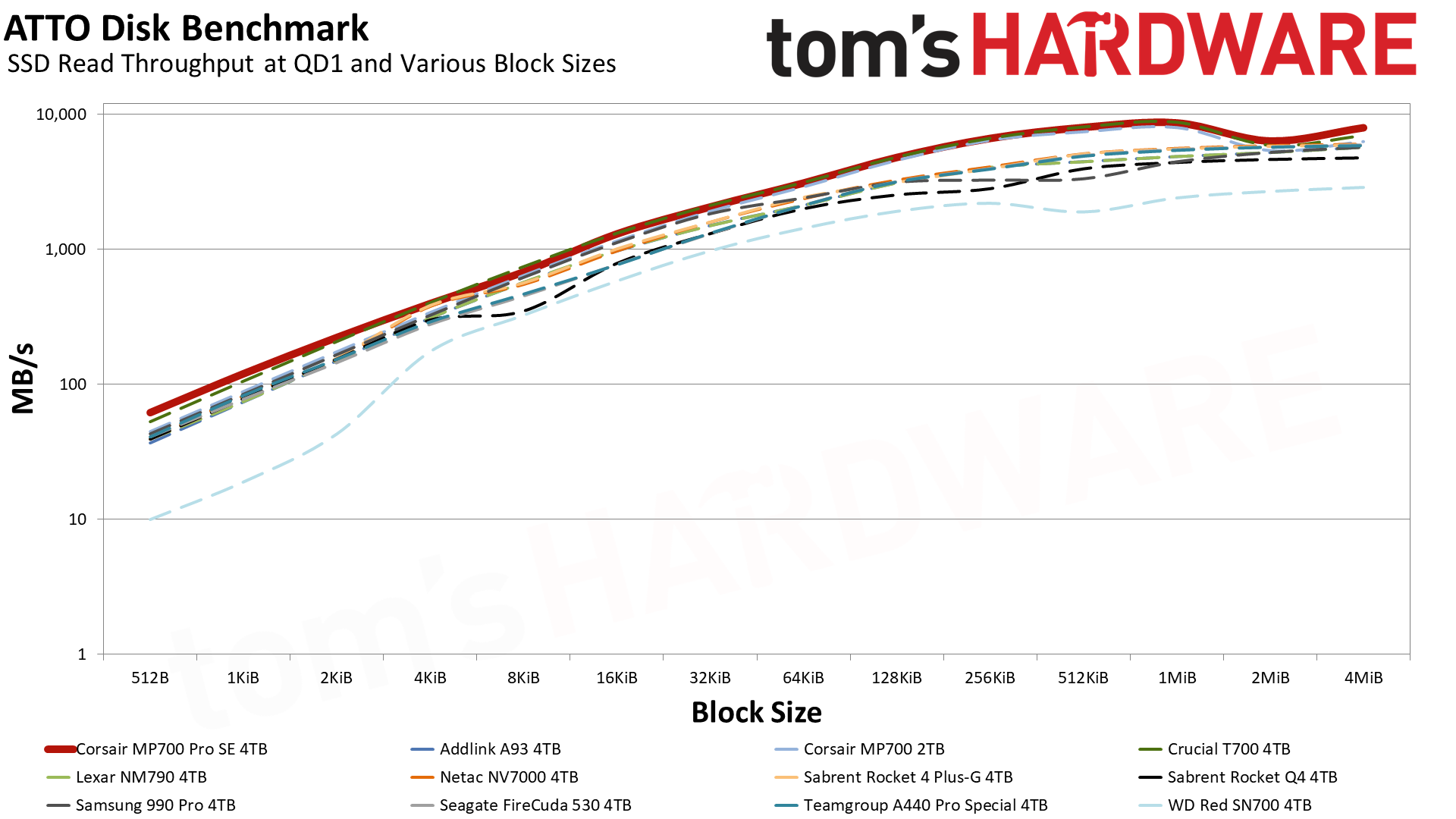

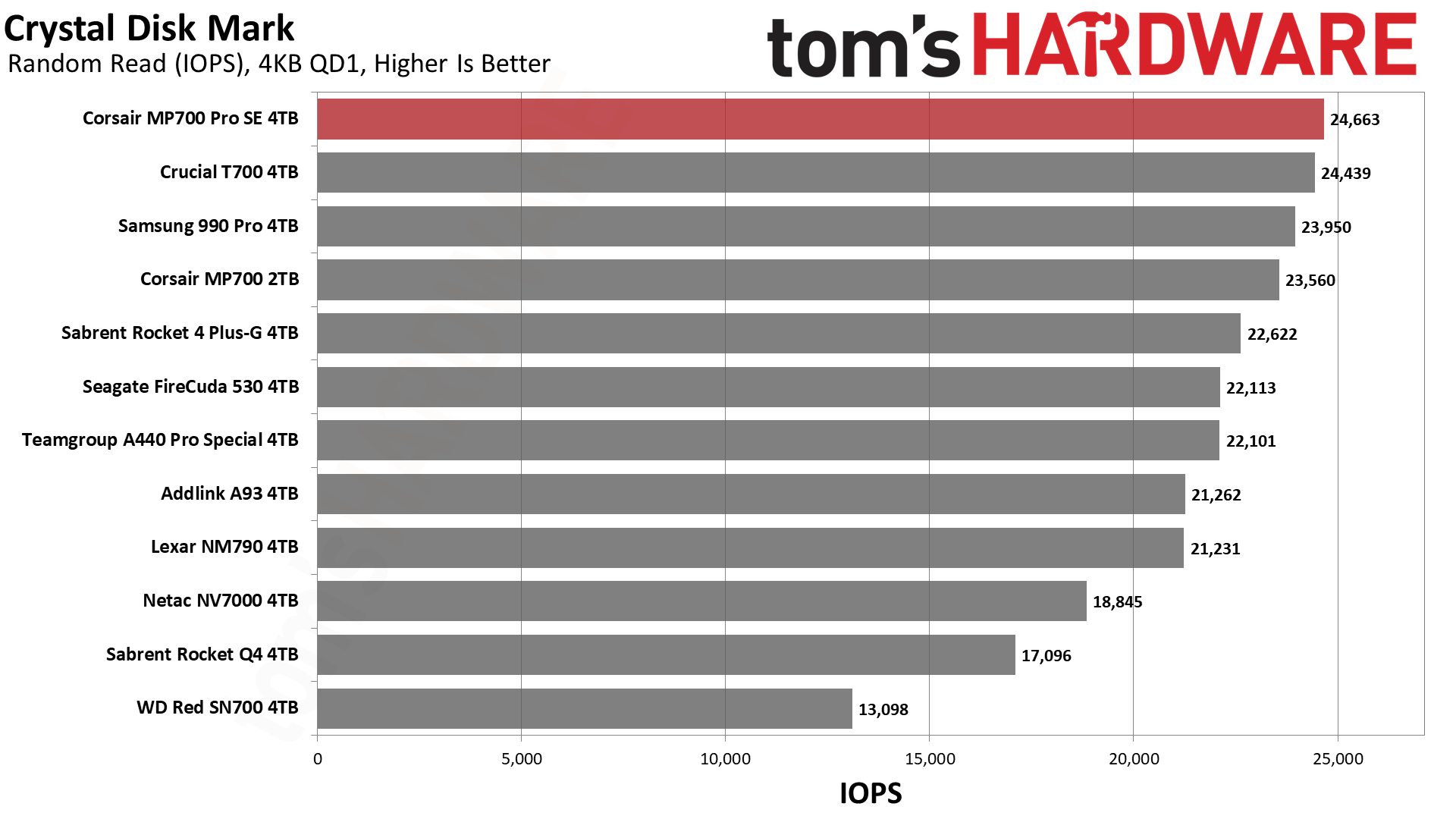
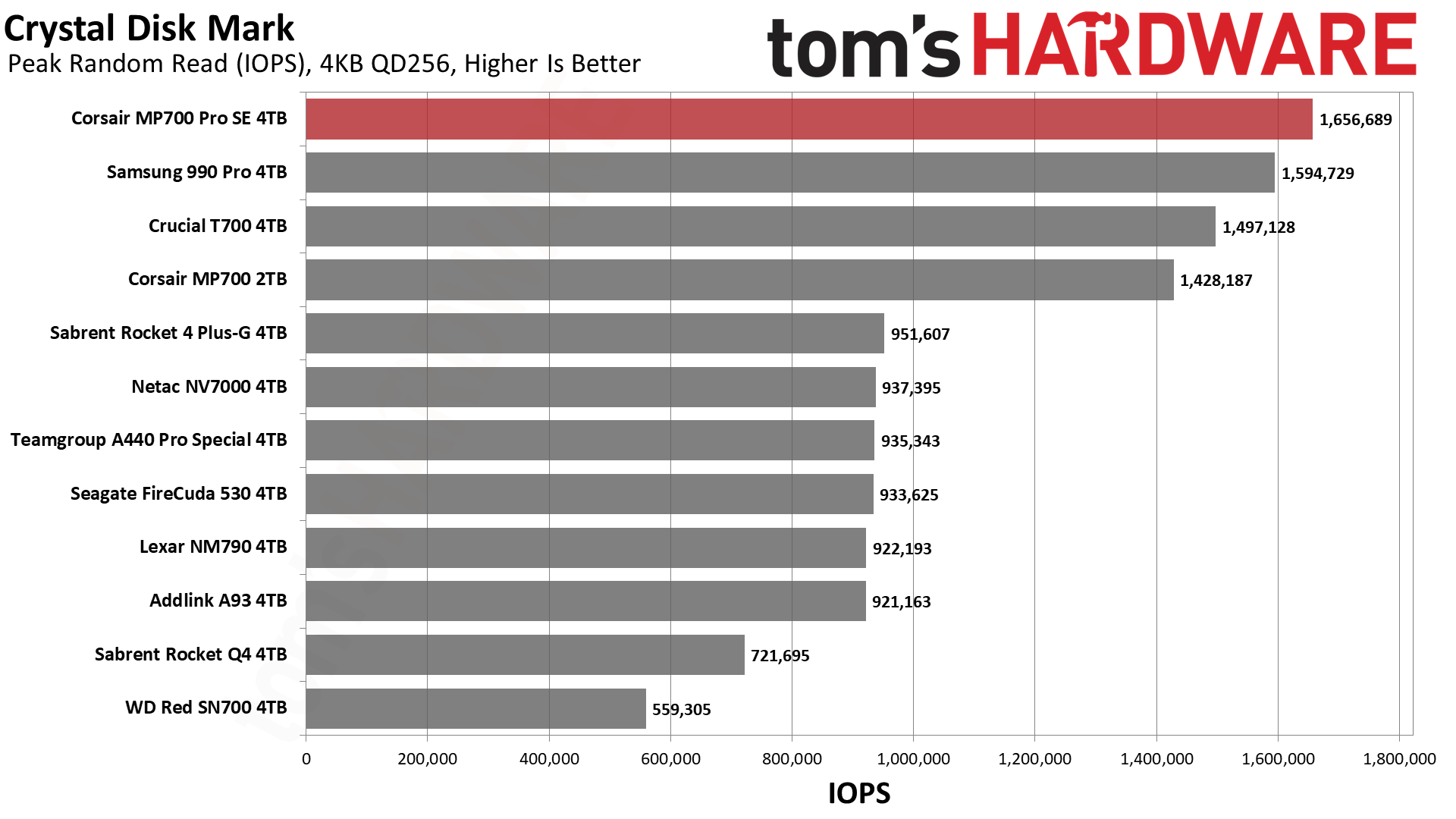
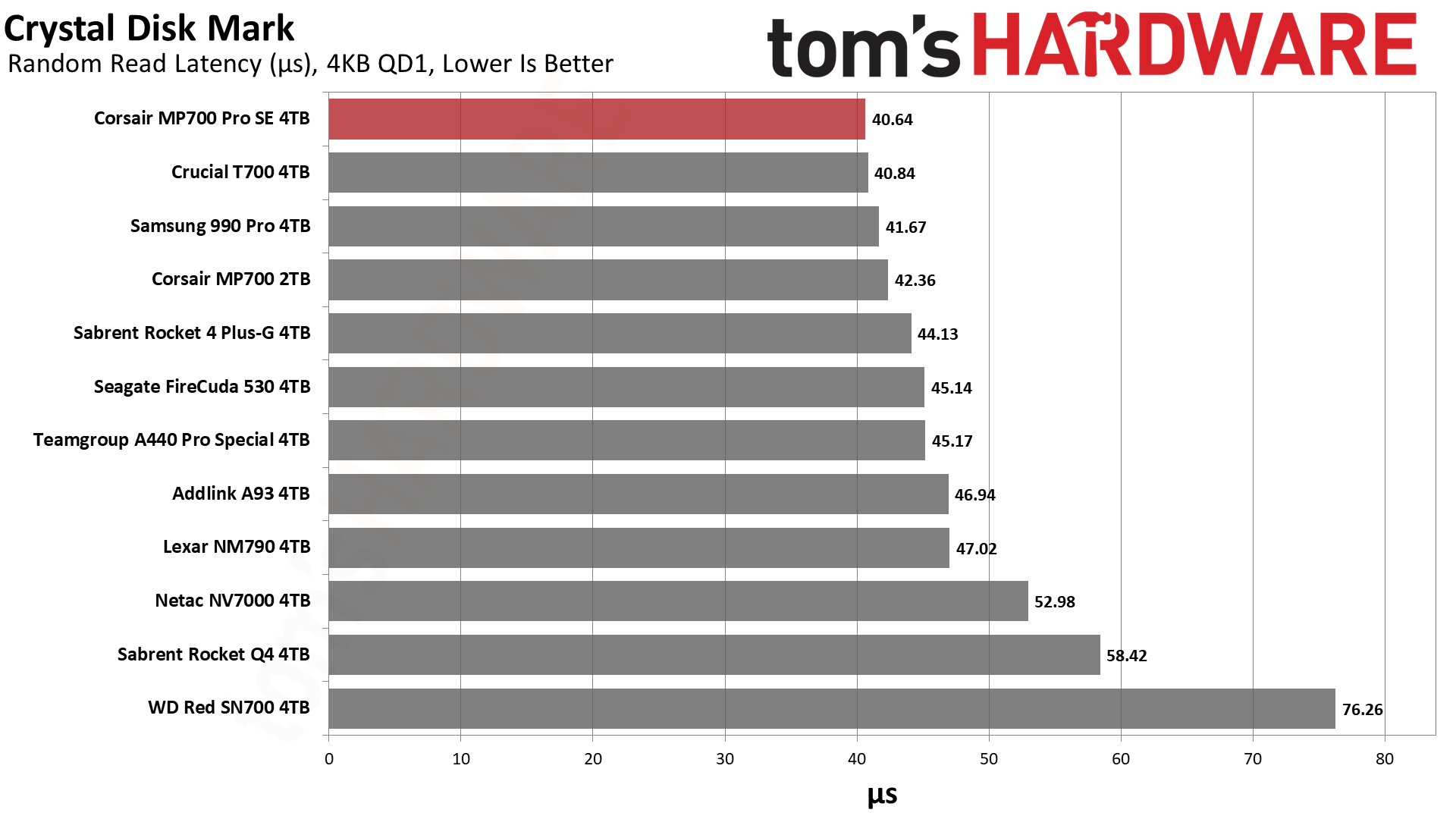
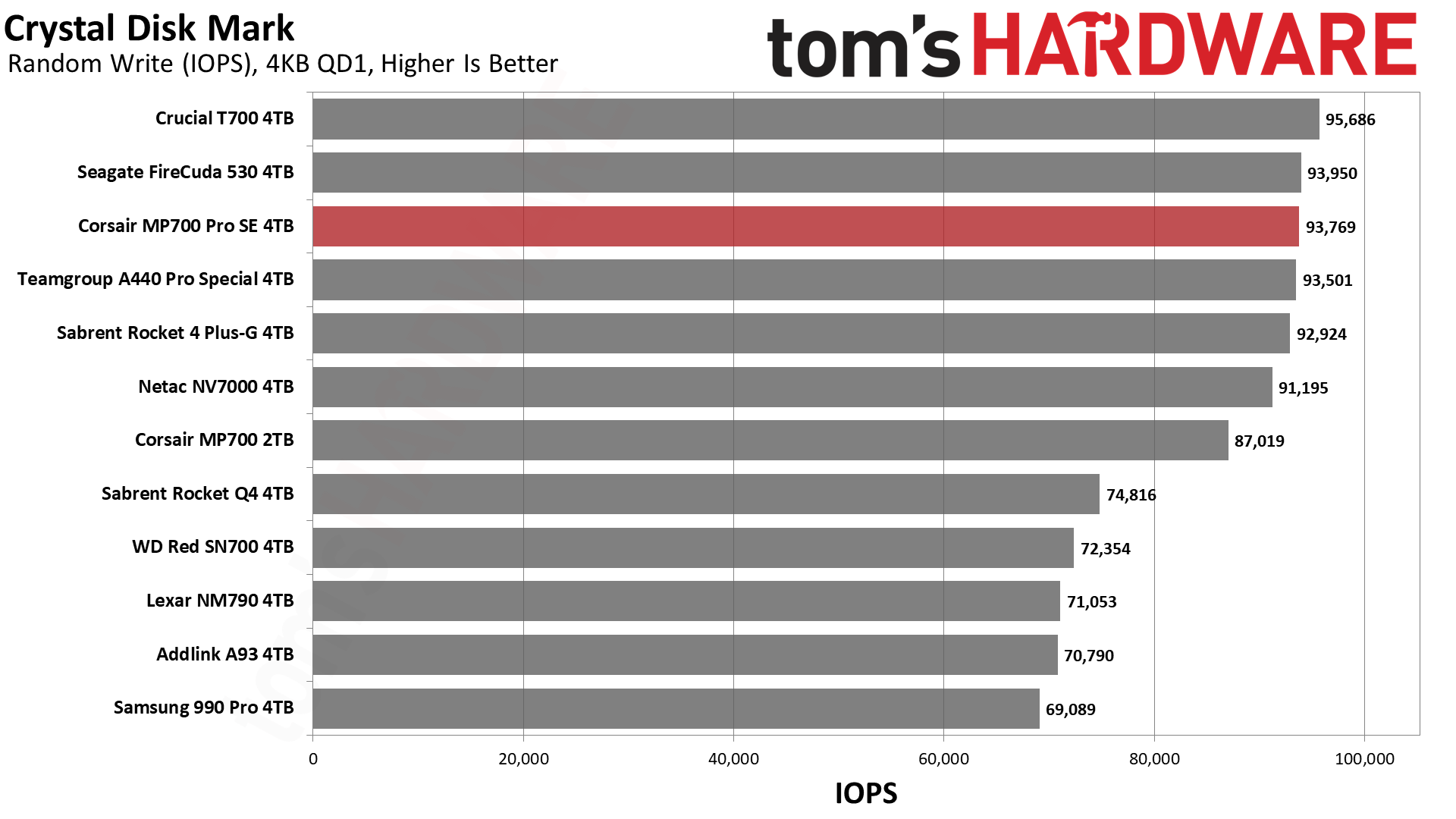
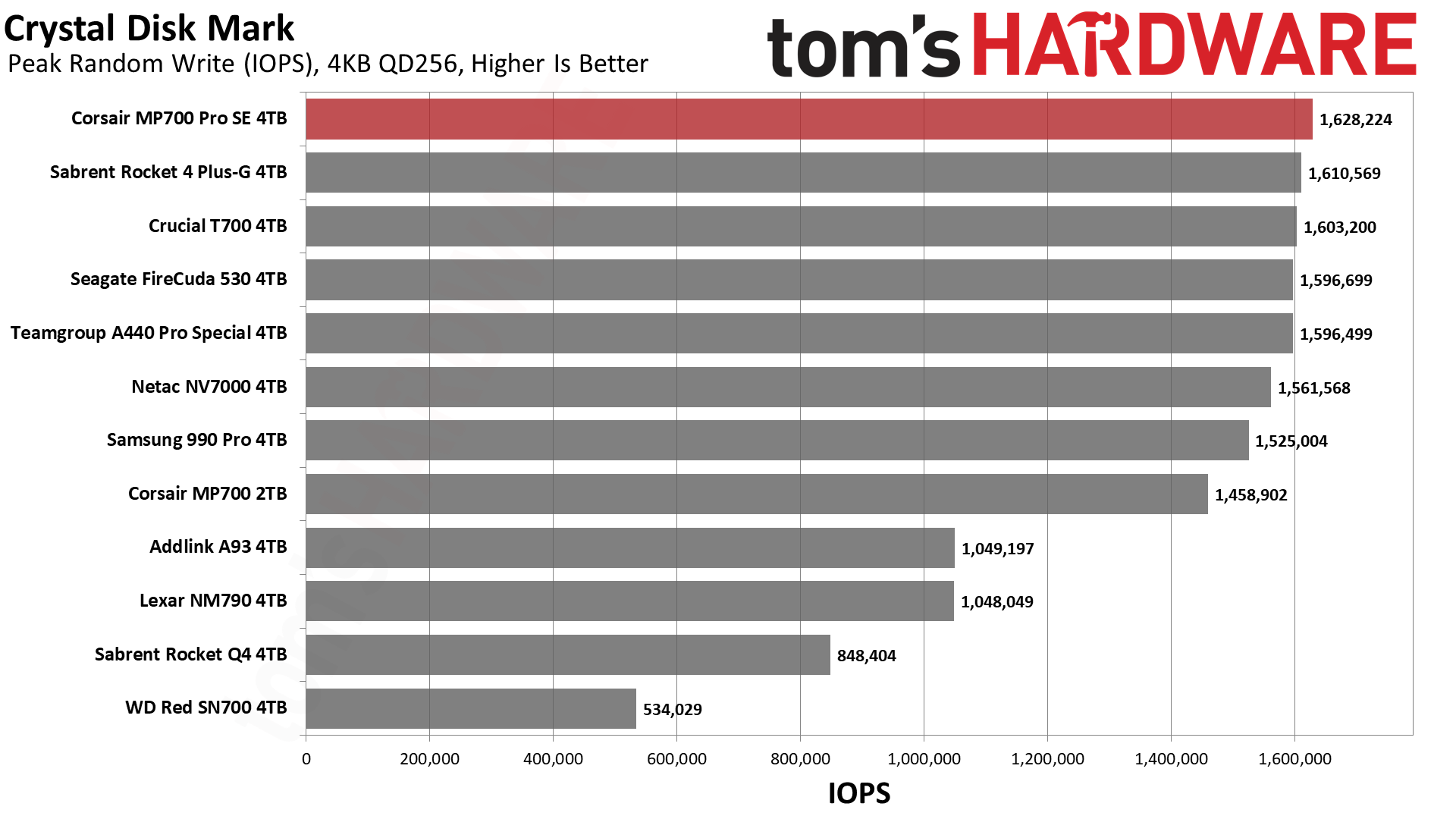


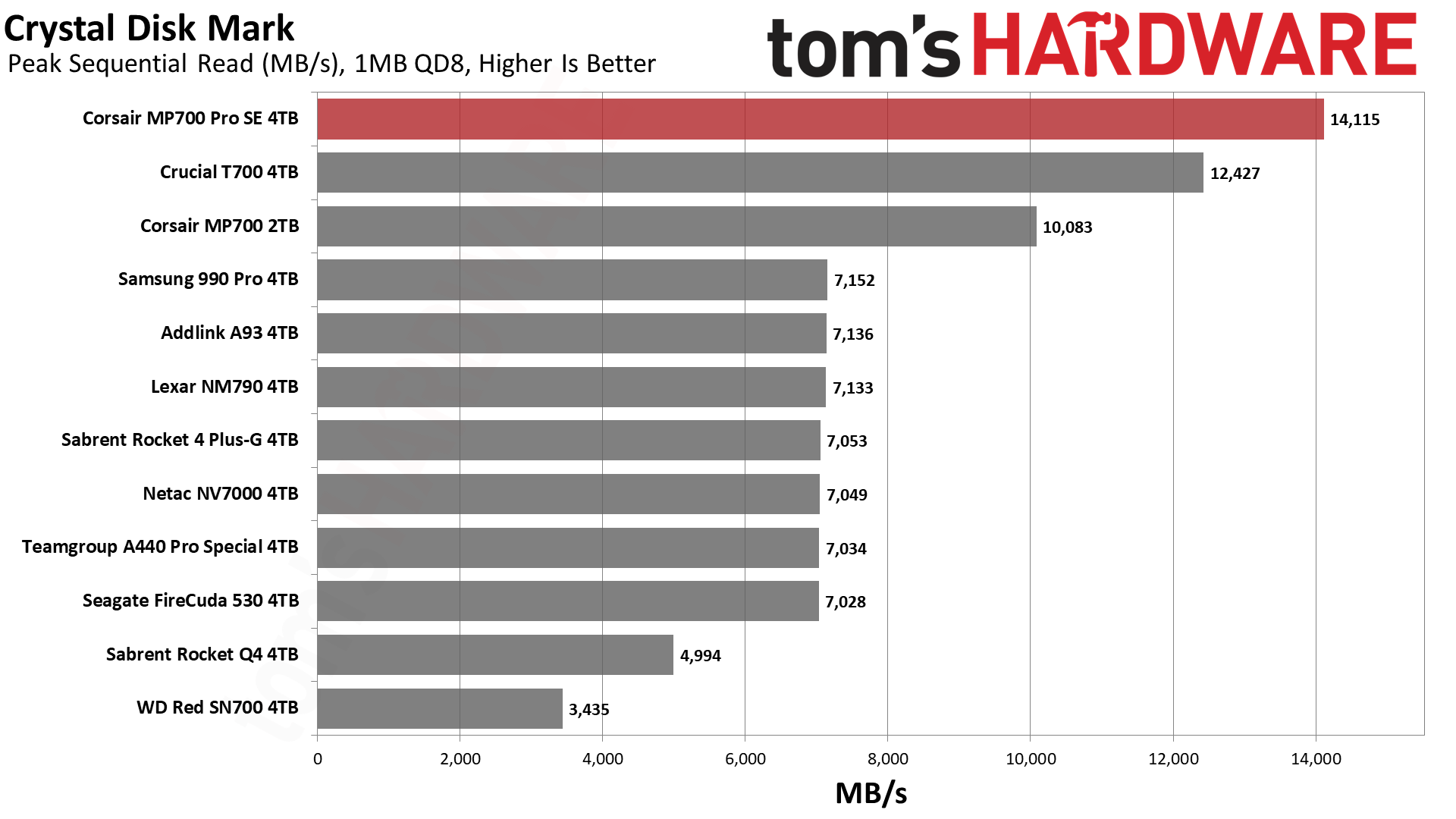
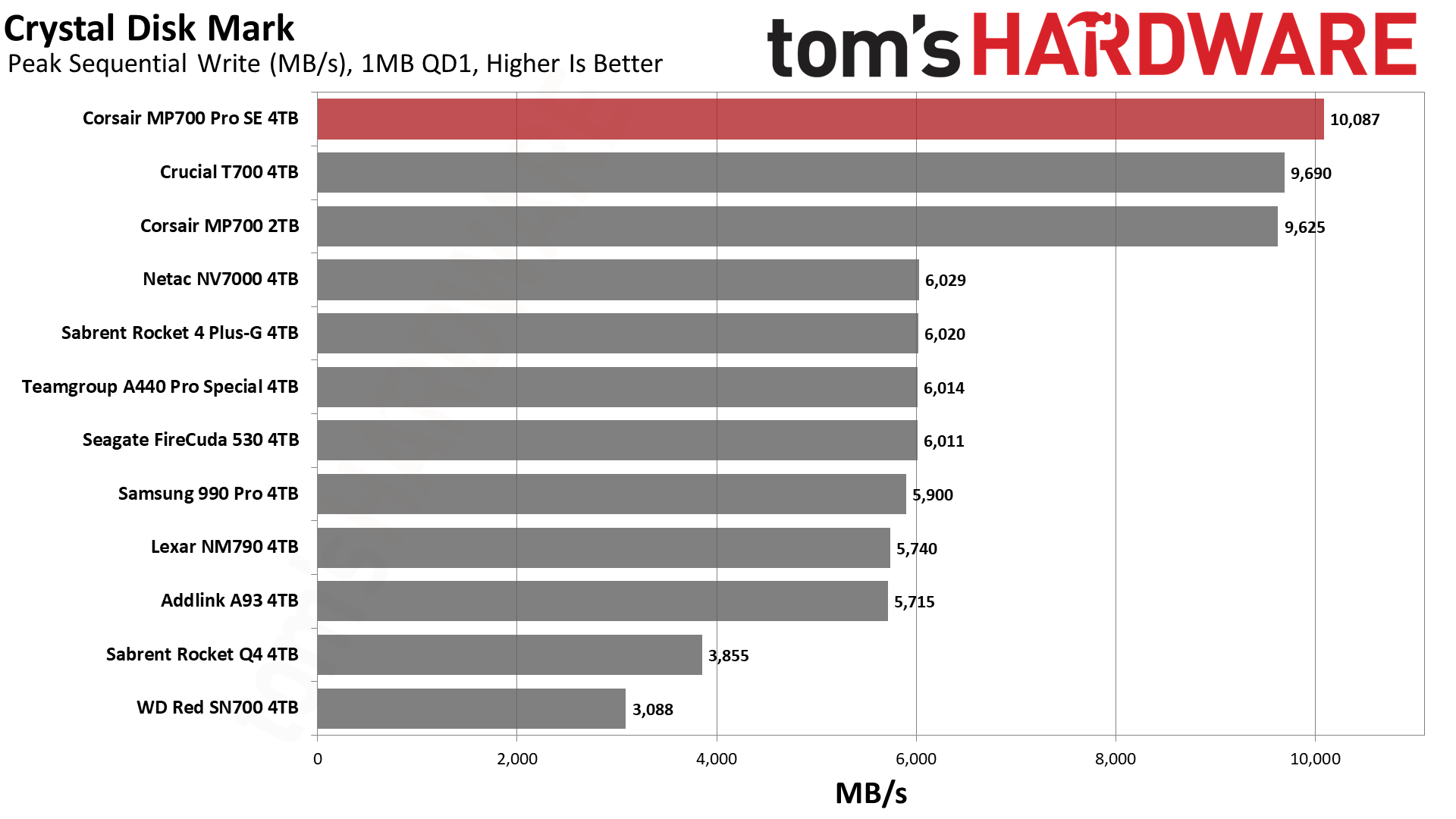

The MP700 Pro SE has exceptional performance in ATTO, being the fastest drive in the lineup. Due to the nature of SSDs, the advantages of this drive don’t show up until a certain I/O size, with the MP700 Pro SE beginning to pull away after 4KiB with the most impressive gains occurring with enough interleaving in the 128KiB+ range.
While the A93 and NM790 have similar flash from YMTC, the four-channel controller found on them can’t keep up past a certain point, against even the E18-based drives like the Rocket 4 Plus-G. Considering the A93 and NM790 are also DRAM-less, this leaves the impression that you still want a robust controller with DRAM for larger I/O, even when restricted to a PCIe 4.0 interface.
The two anomalies here, tracking the MP700 Pro SE, are for reads at 2MiB and for sub-4KiB writes. For the reads, this is typical for this controller and flash combination, perhaps being related to the superpage barrier. The eight-channel controller with 16KiB physical pages per die with peak performance at two dies per channel — since this flash is six-plane, which hits an interleaving cap more quickly — yields a superpage of 1.5MiB, which might explain the dip.
As for the writes, these are sub-page in size, which could be handled differently in enterprise workloads which might explain the odd results here. One reason a controller might have extra DRAM — as is the case with this drive — could be to handle smaller I/O like this in a more efficient and consistent way, so these lower numbers might be deceptive.
With CDM, we see that the MP700 Pro SE has excellent sequential performance. This is particularly true with sufficient queue depth, which is at QD8 in the standard test. There’s just no substitute for a PCIe 5.0 SSD when it comes to throughput. This drive quadruples what’s possible with the 3.0-based SN700, which can make a big difference with data-intensive workloads. That said, the drive is also very fast with random I/O, showing excellent 4KB random read and write latency. You can get by with the 990 Pro, however, if you’re on a 4.0 system and want the best 4KB random read latency.
Sustained Write Performance and Cache Recovery
Official write specifications are only part of the performance picture. Most SSDs implement a write cache, which is a fast area of (usually) pseudo-SLC programmed flash that absorbs incoming data. Sustained write speeds can suffer tremendously once the workload spills outside of the cache and into the "native" TLC or QLC flash.
We use Iometer to hammer the SSD with sequential writes for over 15 minutes to measure both the size of the write cache and performance after the cache is saturated. We also monitor cache recovery via multiple idle rounds. This process shows the performance of the drive in various states as well as the steady state write performance.
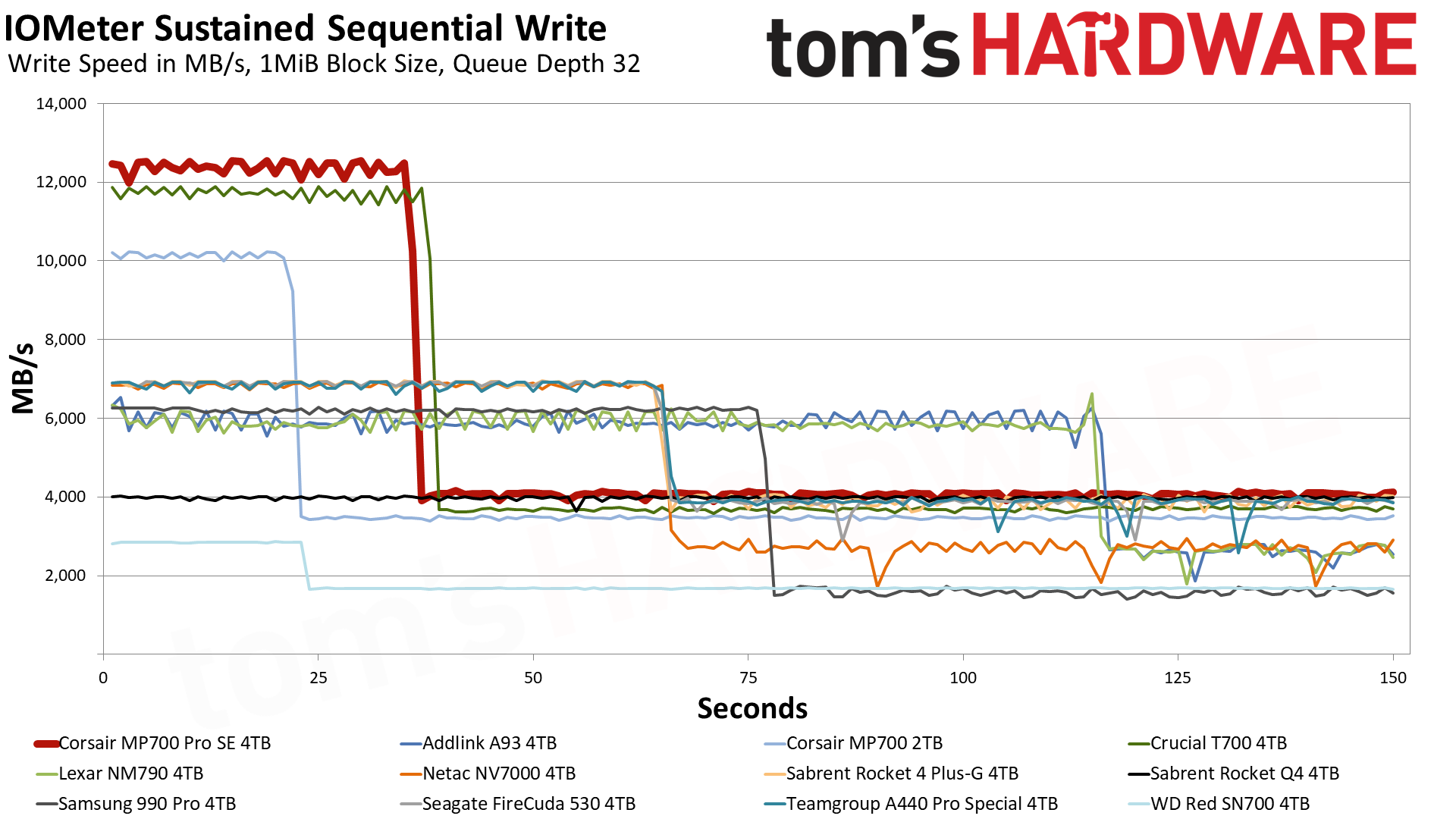

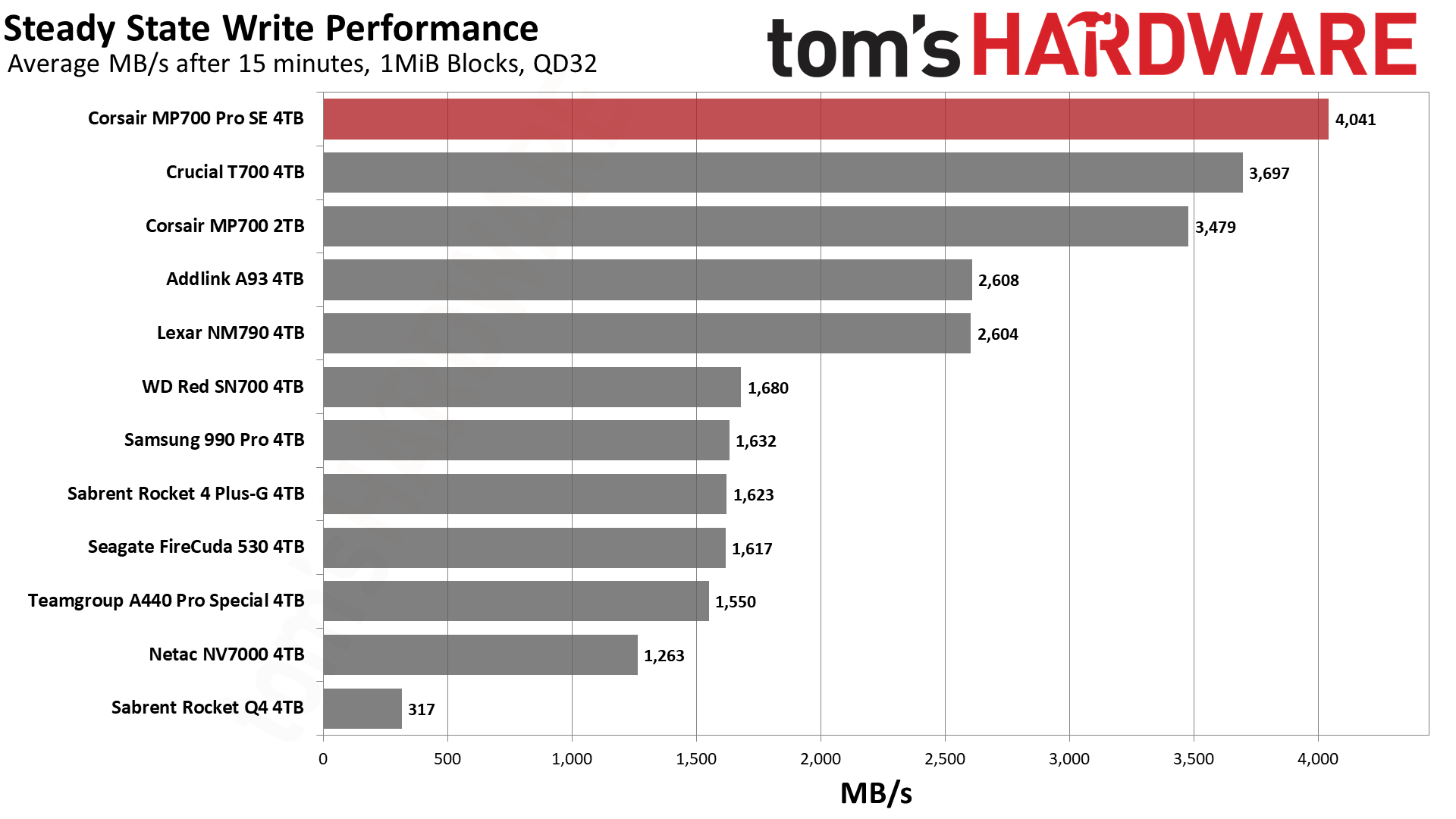
The MP700 Pro SE 4TB writes in pSLC mode at 12.3 GB/s for approximately 36 seconds, yielding a 440GB cache. This is twice the cache size we've seen on 2TB drives with this hardware, so that makes sense. Usually caches will scale in size relative to the total capacity, which can impact steady state performance in some cases. Other drives including the E27T-based SSDs like Corsair’s MP600 Elite have a consistent cache size across capacities, which is less common.
Once the pSLC cache is exhausted the MP700 Pro SE hits a direct-to-TLC mode at around 4 GB/s. This is also standard for this hardware, but the Rocket 5 is special for maintaining 4.45 GB/s with Sabrent’s optimizations. If sustained write performance is super important to you, that drive has an edge, but 4 GB/s on the MP700 Pro SE is still very high. Some PCIe 4.0 drives can get pretty close in TLC mode, like the Rocket 4 Plus and Plus 4-G. Eventually, the MP700 Pro SE hits the folding state with around 1.5 GB/s, which is still pretty respectable. Based on our testing, when left to its own devices, this drive will recover to TLC write speeds but takes longer for pSLC recovery.
Power Consumption and Temperature
We use the Quarch HD Programmable Power Module to gain a deeper understanding of power characteristics. Idle power consumption is an important aspect to consider, especially if you're looking for a laptop upgrade as even the best ultrabooks can have mediocre stock storage. Desktops may be more performance-oriented with less support for power-saving features, so we show the worst-case metrics here.
Some SSDs can consume watts of power at idle while better-suited ones sip just milliwatts. Average workload power consumption and max consumption are two other aspects of power consumption but performance-per-watt, or efficiency, is more important. A drive might consume more power during any given workload, but accomplishing a task faster allows the drive to drop into an idle state more quickly, ultimately saving energy.
For temperature recording we currently poll the drive’s primary composite sensor during testing with a 21-22°C ambient. Our testing is rigorous enough to heat the drive to a realistic ceiling temperature.
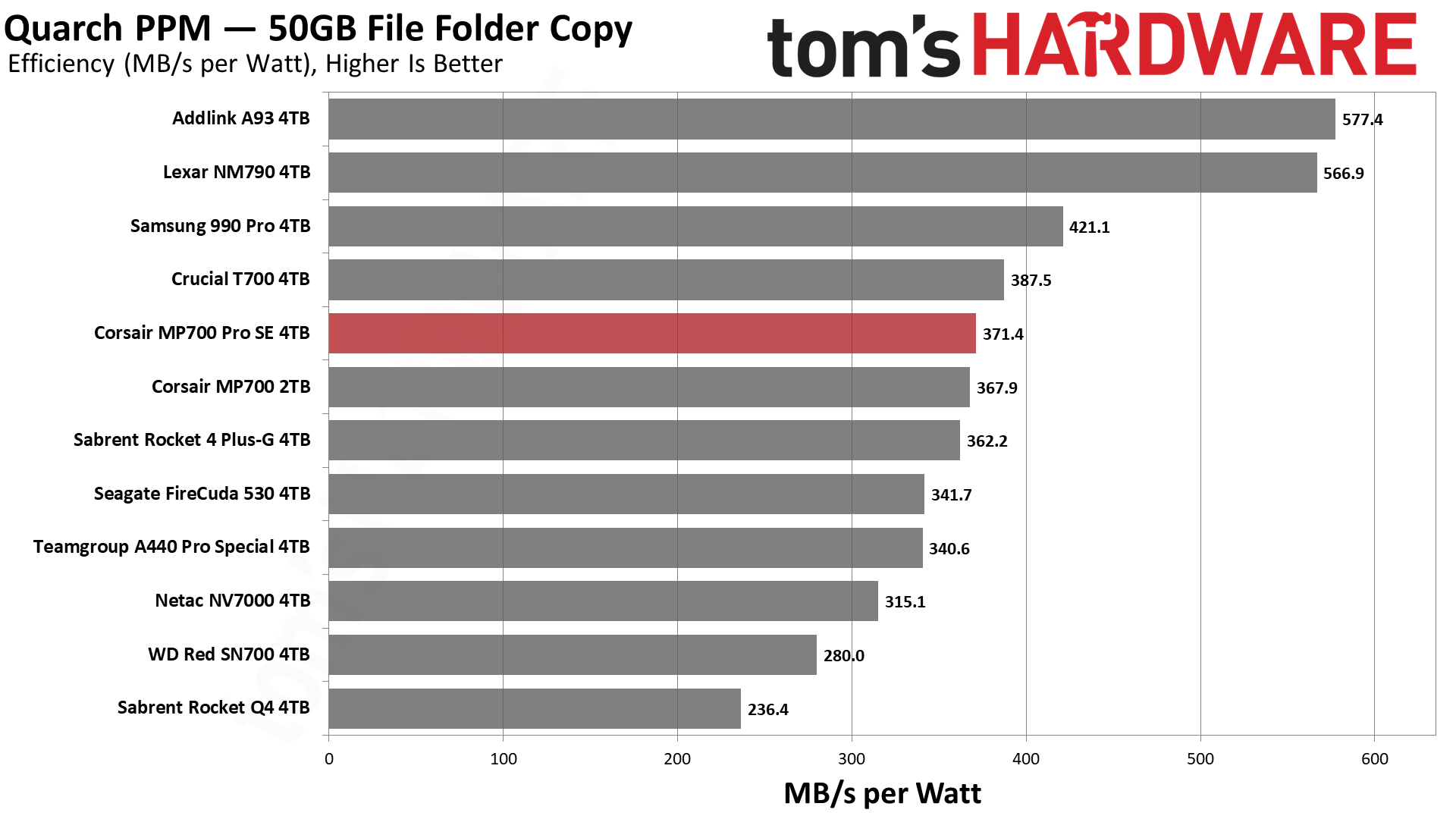

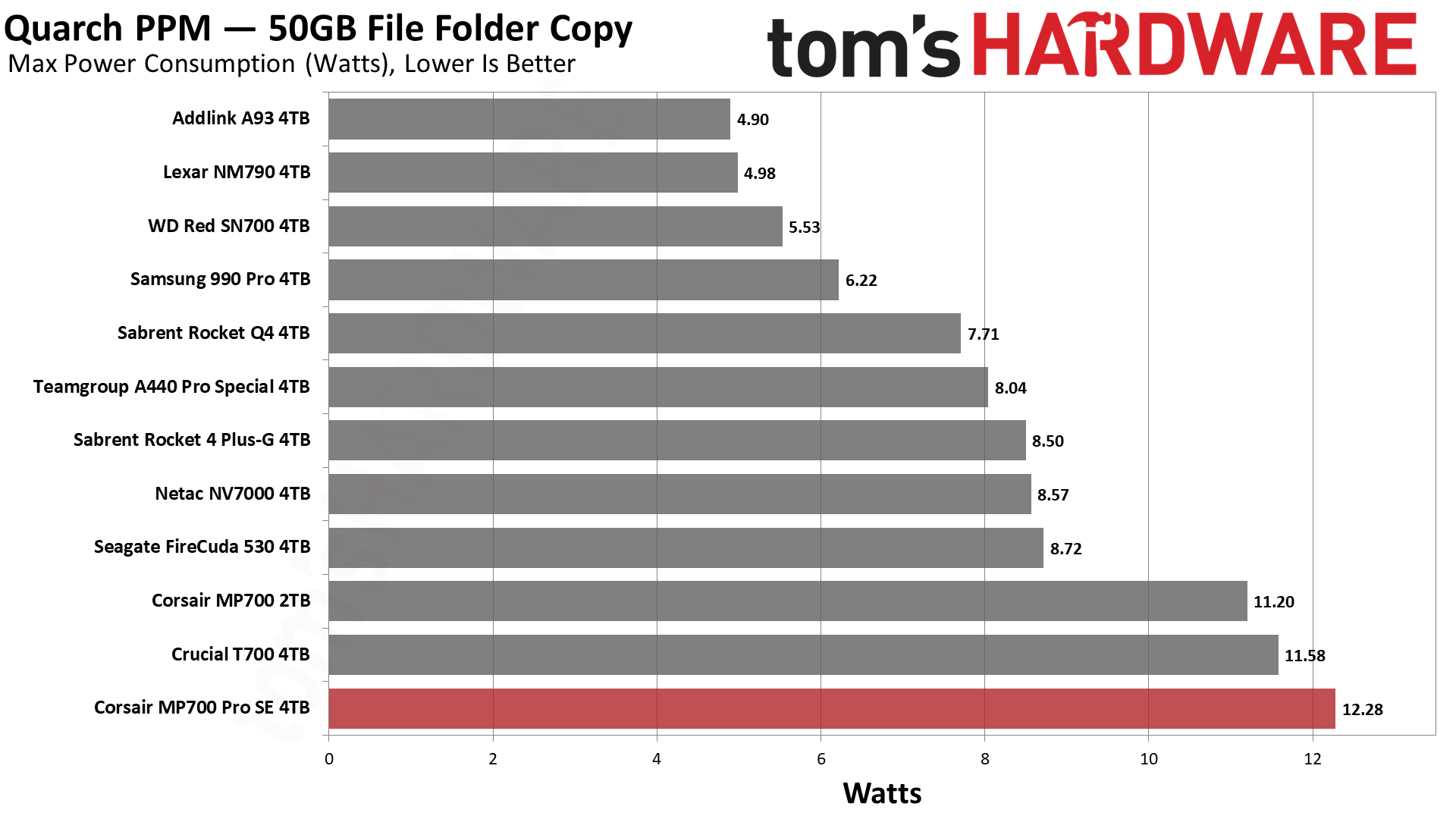
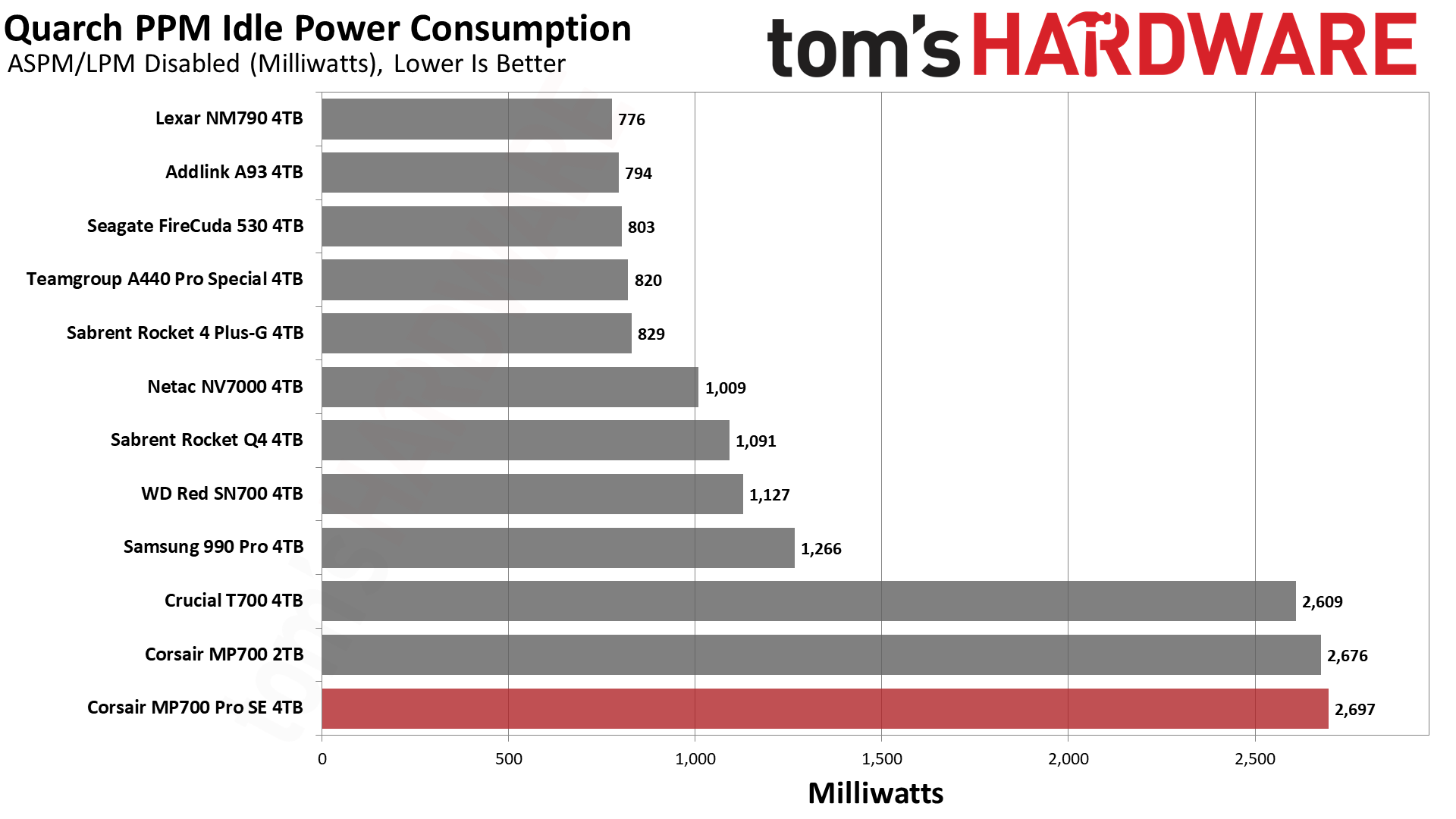
The Achilles Heel of the Phison E26 controller can be found in its power consumption. The MP700 Pro SE can pull over 12W and its power efficiency on the whole is mediocre at best. Idle power consumption is also a problem, but this drive is designed specifically for high performance desktop environments where 2-3 extra watts likely isn't a big deal. You’ll have to wait a while longer if you want an efficient PCIe 5.0 SSD.
Power consumption also means heat generation. This drive requires a heatsink for proper operation and it’s a good idea to keep it below about 80°C at all times to prevent throttling. In our testing the drive topped out at 70°C, which is a decent maximum operating temperature. There’s sufficient headroom that even hotter environments should pose no issue.
Note that we're testing the bare drive with active fan cooling, as that's the only option outside of third-party heatsinks when using the Quarch HD hardware. Liquid cooling or even the heatsinked version of the drive should run substantially cooler. As Corsair’s Hydro X is designed to cool the entire drive there should be no hotspot issues, which could have been a concern with composite throttling if only the controller had been cooled. Additionally, while it’s true that NAND flash can program 'better' at somewhat higher temperatures, the thermal range of this drive with liquid cooling and a normal ambient should be perfectly fine.
Test Bench and Testing Notes
| CPU | Intel Core i9-12900K |
| Motherboard | Asus ROG Maximus Z790 Hero |
| Memory | 2x16GB G.Skill DDR5-5600 CL28 |
| Graphics | Intel Iris Xe UHD Graphics 770 |
| CPU Cooling | Enermax Aquafusion 240 |
| Case | Cooler Master TD500 Mesh V2 |
| Power Supply | Cooler Master V850 i Gold |
| OS Storage | Sabrent Rocket 4 Plus 2TB |
| Operating System | Windows 11 Pro |
We use an Alder Lake platform with most background applications such as indexing, Windows updates, and anti-virus disabled in the OS to reduce run-to-run variability. Each SSD is prefilled to 50% capacity and tested as a secondary device. Unless noted, we use active cooling for all SSDs.
Corsair MP700 Pro SE Bottom Line
The Corsair MP700 Pro has all the performance you’d expect without any noteworthy drawbacks, other than pricing. It has the latest firmware, which is not only DirectStorage-optimized but also implements Phison’s improved thermal throttling algorithm. Corsair offers the drive in 2TB and 4TB, with multiple SKUs based on capacity: The bare drive will only be available on the 4TB model, while the heatsink and Hydro X options will be available at both capacities. In short, this drive is the pinnacle of home storage right now, and Corsair made sure to nail the launch this time.
Currently, its two main rivals are the Corsair T705 and the Sabrent Rocket 5, both of which now come in bare and heatsink variants. The Rocket 5 does have firmware optimizations that give it higher sustained write performance — in fact it has the highest sustained write performance of any drive we’ve ever tested. That could give it an edge over the MP700 Pro SE as well as the T705. Corsair’s drive stands out with its liquid-cooled option, plus the fact its heatsink SKU can optionally run with a fan. It’s certainly possible to get aftermarket M.2 SSD coolers for these drives, but Corsair’s SKU has a very small price premium that makes it the best choice if you absolutely need that.
There are other, slightly slower PCIe 5.0 SSDs, such as Gigabyte’s Aorus Gen5 12000, the Teamgroup Cardea Z540, and the Inland TD510. It does seem silly to 'only' go for 10 or 12 GB/s when you can get more bandwidth out of the MP700 Pro SE. It’s also silly to go for a 1TB drive when such a drive can’t reach those performance heights, which is why Corsair only offers this drive at 2TB and 4TB. The original MP700 Pro might be a good bargain pick on sale, but an enthusiast looking to go all out will want the MP700 Pro SE, satisfying the craving for maximum performance without any second guessing.
If you’re on a tighter budget — and storage is certainly a place where you can save money in a build — there are a ton of great PCIe 4.0 SSDs. If capacity is important, the Samsung 990 Pro is as good as it gets, with the WD Black SN850X not far behind. Or you can save even more by going DRAM-less, which is a better option for laptops and the PS5, with the Lexar NM790 or Addlink A93 respectively.
At 2TB and below, there are myriad viable options, and in general we can recommend the Sabrent Rocket 4 or, for desktops and the PS5, the Corsair MP600 Elite. Unless you really want DRAM, in which case the Crucial T500 remains your best bet — unless you’re game to go with drives that have been around much longer. Those older drives, like the Inland Gaming Performance Plus, have the benefit of DRAM and the potential of higher TLC write performance, but are also less power-efficient and less ideal for laptops in particular. Going by pure price per GB, though, the least expensive drive will generally do for the PS5.
Is it worth buying the MP700 Pro SE in other cases? We certainly think so, if you want the very best performance and the Hydro X option appeals to your build. We’re less sold on the bare and heatsink options as the T705 and Rocket 5 already fill those roles. The Rocket 5 is also the better choice for sustained performance. Where the T705 comes into play is price, as it's been out longer and directly competes with the MP700 Pro SE. It’s simply a matter of deciding what capacity you want — at least until we see drives like this at 8TB. For now, this is as good as it gets at 2TB and 4TB. It just costs more to get a top-tier PCIe 5.0 SSD, and that's not likely to change any time soon.
MORE: Best SSDs
MORE: Best Hard Drive
MORE: Best SSD for the Steam Deck
- 1
- 2
Current page: Corsair MP700 Pro SE 4TB Performance Results
Prev Page Features and Specifications
Shane Downing is a Freelance Reviewer for Tom’s Hardware US, covering consumer storage hardware.
-
JarredWaltonGPU Reply
Um, no. The MP700 Pro SE 4TB drive has 3,000 TBW of endurance, not 300 TBW.8086 said:The Crucial T705 has twice the endurance of the Corsair MP700 PRO SE. 600 TBW vs 300TBW. -
LaminarFlow To me the trend with PCIe 5.0 drives almost feel like the early-mid 2000s CPU clock race, chasing superficial speed crown while getting pricier and worse and worse with heat/efficiency.Reply
95% of actual usage can't really distinguish this vs a decent PCIe 3.0 drive. I'll be getting an upgrade to my 1TB drive this summer, and I sure as heck won't be buying anything PCIE 5.0 -
8086 Reply
I knew that. It was a Typo to say 600 instead of 6,000.JarredWaltonGPU said:Um, no. The MP700 Pro SE 4TB drive has 3,000 TBW of endurance, not 300 TBW. -
Li Ken-un Reply
It’s good for one thing though: adding a lot of SSDs or more than two graphics cards (for whatever reason a prosumer might want that). You’ll pay dearly for the switch and cables/risers to make it happen right now though.LaminarFlow said:95% of actual usage can't really distinguish this vs a decent PCIe 3.0 drive. I'll be getting an upgrade to my 1TB drive this summer, and I sure as heck won't be buying anything PCIE 5.0
$100 for a single SlimSAS 8i cable… and they get even pricier as you get into specialty niches that are beyond the realm of prosumers who just need bandwidth, storage capacity, and GPUs to play with AI/ML. -
helkins The author repeatedly mentions the Crucial T705 as the MP700 SE's chief rival - yet did not feel compelled to include the T705 in any of the benchmark comparisons? That is a profoundly terrible omission!Reply
Sidenote; Tom's is completely unusable on a current iPhone using either Chrome or Safari, just inexcusable and insufferable! Had to get to a desktop to comment here. -
JarredWaltonGPU Reply
Even if it's 6000 vs 3000, it's still mostly meaningless. I have a 2TB SSD (an old Samsung 850 Pro SATA model) that I've been using for about nine years, and it still only has 160TB of writes. I download movies/videos to it all the time, as well as processing videos and other content over on that drive, so it gets way more of a workout than my typical SSDs.8086 said:I knew that. It was a Typo to say 600 instead of 6,000.
Anything over 1000TBW for a home PC basically means you'll never hit that limit unless you're intentionally just pounding the drive with writes all the time (i.e. using some synthetic utility like Iometer or whatever).
We didn't test the T705 4TB, so we focused on other 4TB drives. The differences between T700 and T705 are well known by now. Higher peak throughput basically on the T705. Given the T705 and MP700 Pro SE use the exact same hardware, the only potentially differentiating factor would be firmware. And even that could be updated so that there's no longer any real difference.helkins said:The author repeatedly mentions the Crucial T705 as the MP700 SE's chief rival - yet did not feel compelled to include the T705 in any of the benchmark comparisons? That is a profoundly terrible omission!
Basically, if you want one of these Phison E26 drives, both Corsair and Crucial are well-known brands with good support. Buy whichever is cheaper.
